Gluten-Free Focaccia with Rosemary
This post may contain affiliate links. Please read our disclosure policy
Our easy gluten-free focaccia recipe has a perfect crispy crust & tender, fluffy center. It’s the easiest gluten-free bread around! (Vegan-Friendly!)
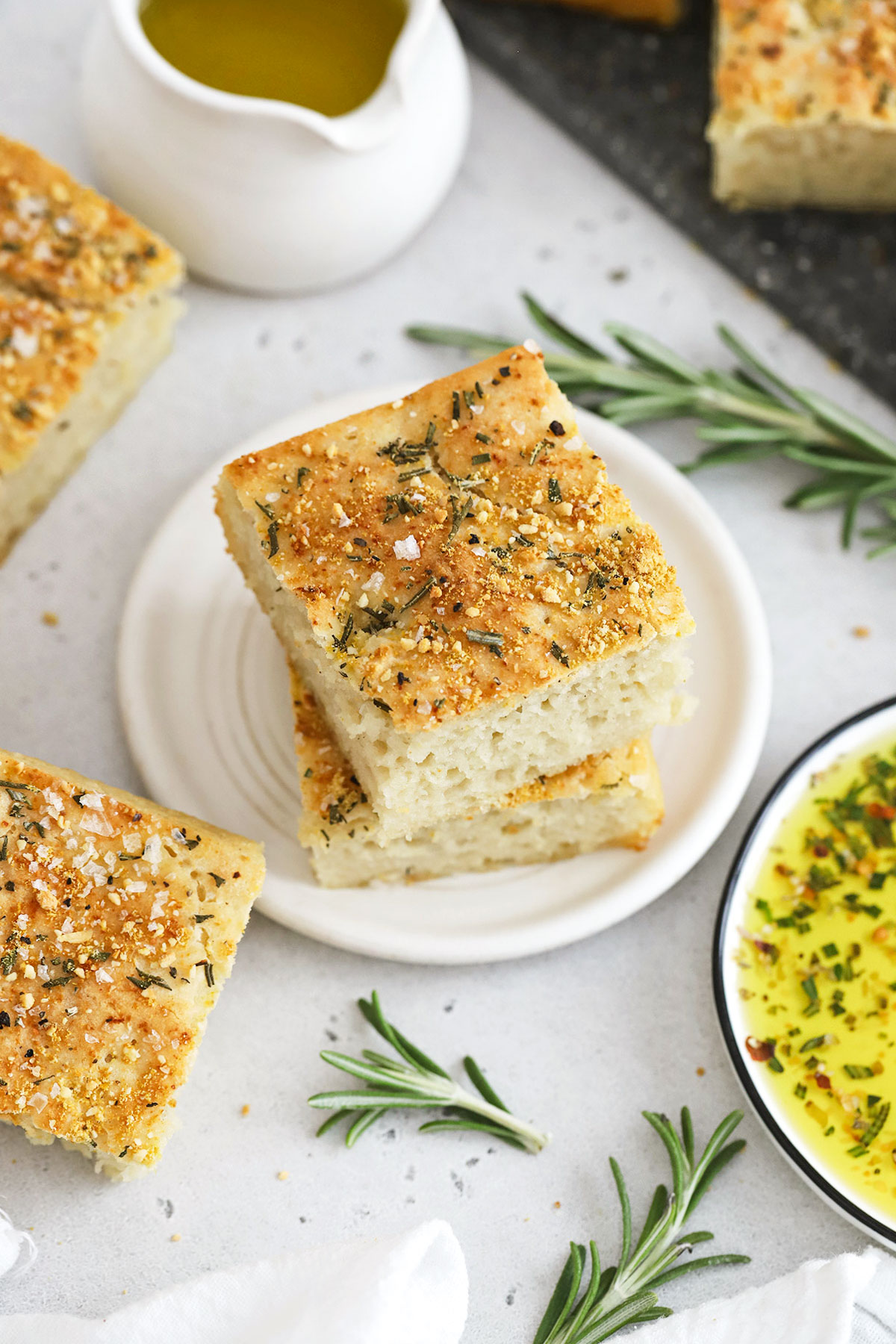
This gluten-free rosemary focaccia has been one of our top posts for the last several years, and it’s better than ever, thanks to updated, more thorough directions & helpful tips!
Before we went gluten-free a decade ago, I used to bake bread all the time. But gluten-free bread is a totally different ballgame! Since there’s no gluten, gluten-free bread dough can be trickier to work with and takes a little extra skill & know-how to get just right.
But do you know what’s probably the easiest gluten-free bread recipe around? Focaccia! This gluten-free focaccia bread recipe has a crisp, golden top and bottom, a soft & pillowy center, and just the right seasonings. It’s enough to send me into a swoon!
If you’re new to gluten free baking or haven’t made gluten-free bread recipes before, don’t worry! We’ve got everything you need to be successful. You’ll be baking loaf after loaf of this delicious Italian bread in no-time!
Lets jump in, yes? The carbs are calling!
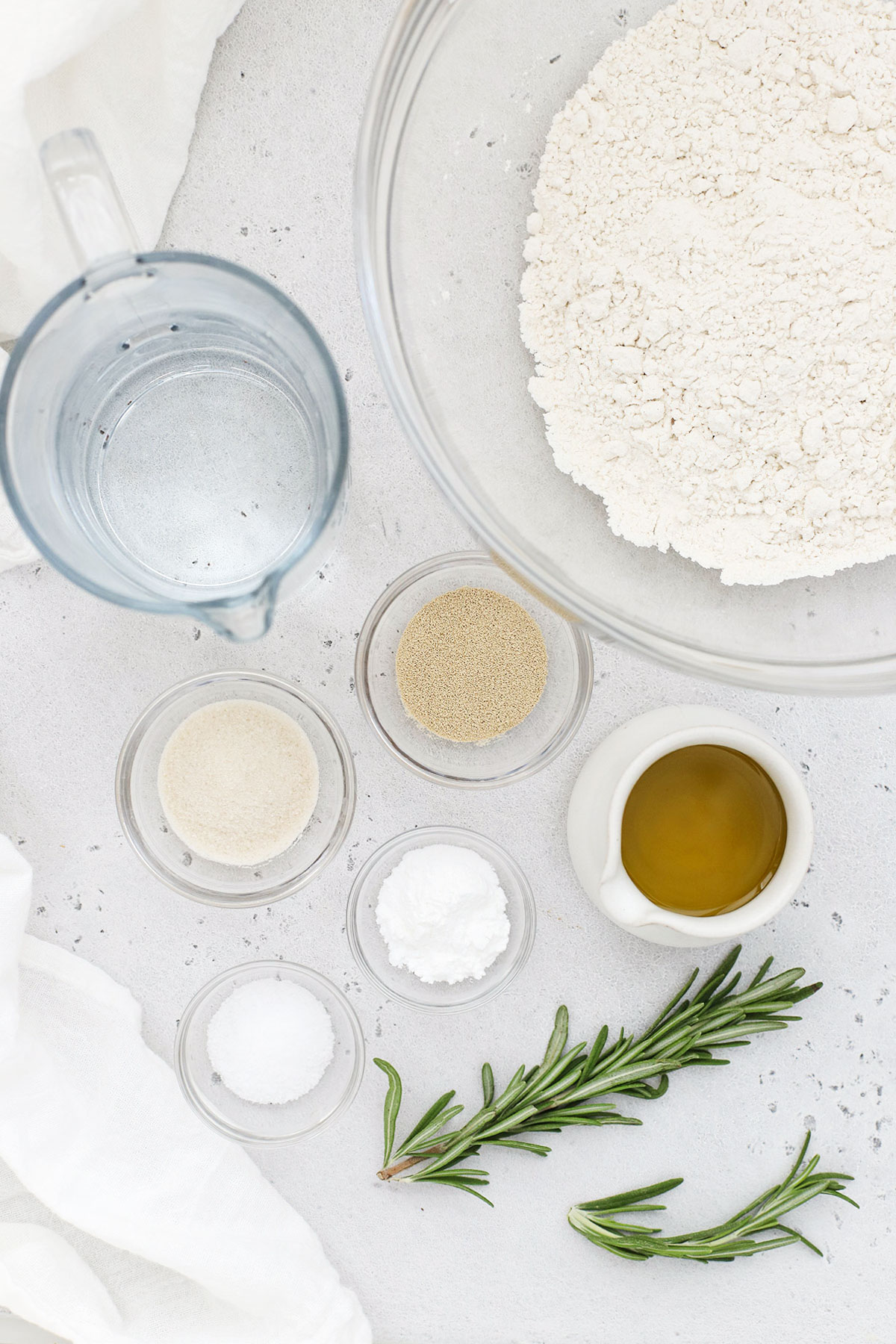
Simple Ingredients For Gluten-Free Focaccia:
- Gluten-Free Flour. You’ll keep things simple with a 1:1 gluten-free flour blend. We HIGHLY RECOMMEND King Arthur Measure For Measure Baking Flour with xanthan gum because it gets nice and golden on top and has the best texture inside. I have also tried it with Bob’s Red Mill 1-to-1 gluten free baking flour with decent results, though the Bob’s Red Mill blend usually doesn’t get quite as crisp or “done” as the King Arthur Blend, and some readers report their focaccia stays wet or gummy in the center when they use the Bob’s Red Mill blend.
- Baking Powder & Salt. Using baking powder with the yeast gives this focaccia a little extra lift and really improves the texture. Then, salt comes in to make the flavor amazing!
- Warm Water. Ideally, the water will be between 120-130 degrees to help activate the yeast. I recommend an instant read thermometer for best results, but you can use the touch test, too. If the water is too warm to comfortably keep your finger in it for a few seconds, it’s too hot!
- Honey or Sugar. Adding a little honey or sugar not only helps with the flavor of this bread, but it also helps activate the yeast. Don’t skip it!
- Active Dry Yeast. We’ve made this with instant yeast and regular yeast. Instant yeast will bloom and rise faster (great when you’re short on time!), and regular dry yeast works well, too.
- Olive Oil. You’ll need plenty of extra virgin olive oil for this focaccia recipe! You’ll use some in the dough, some on the pan, some on top, and some to dip!
- A Few Toppings. Then, you’ll top the focaccia with a few little extras before baking. I like a mix of fresh rosemary, parmesan cheese (or vegan parmesan cheese), flaky salt, and black pepper.
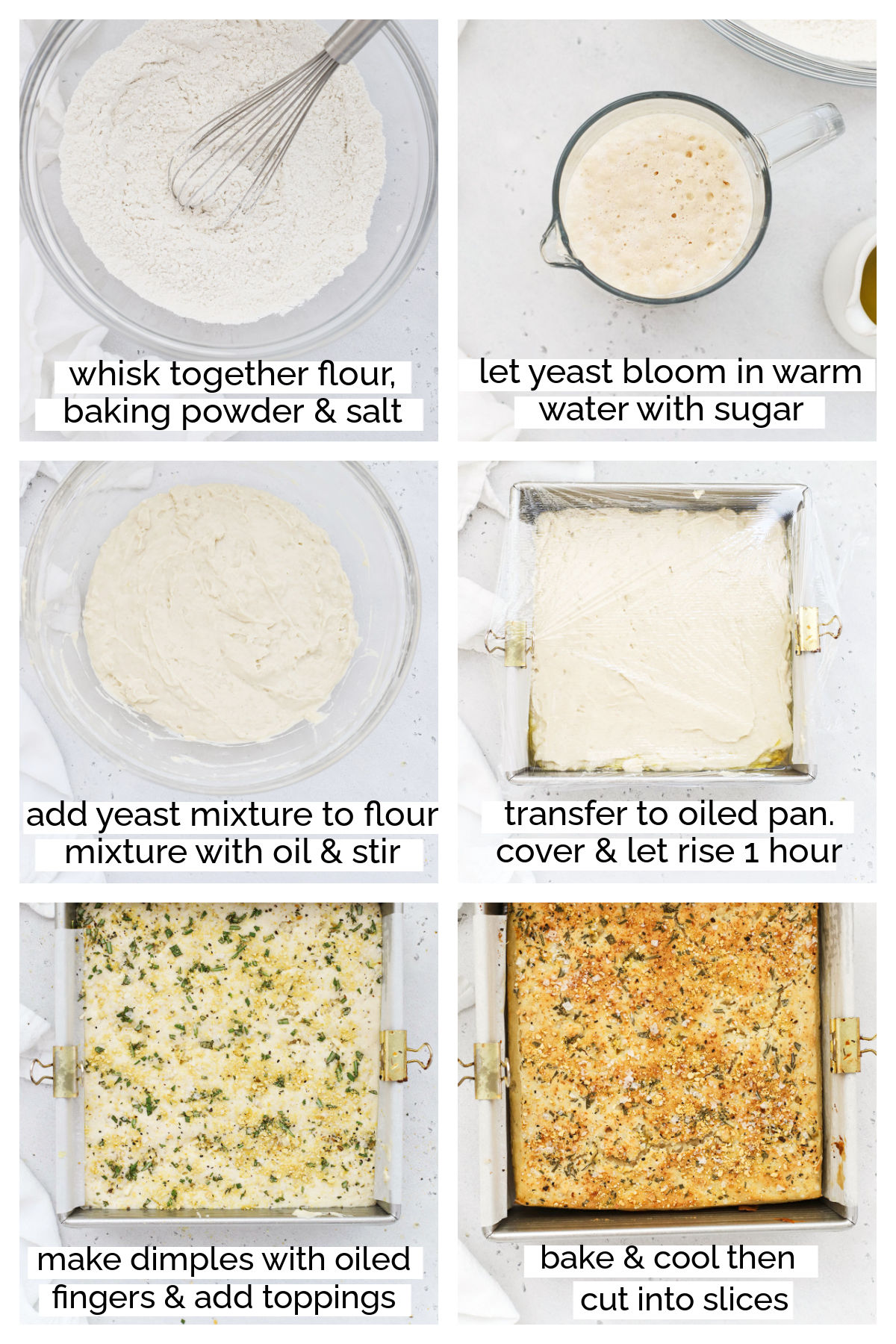
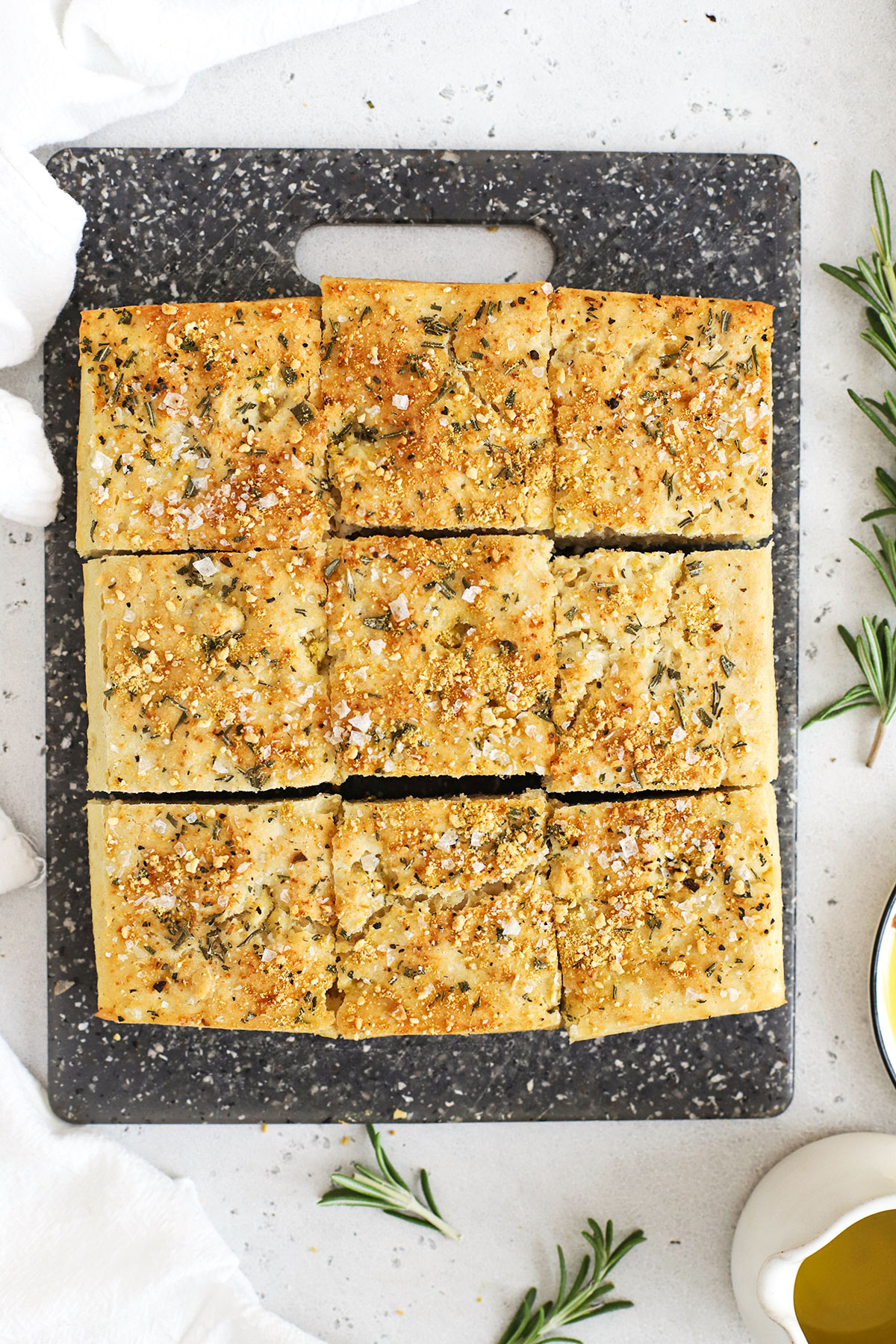
How To Make Gluten-Free Focaccia Step By Step:
- Combine Dry Ingredients. In a large mixing bowl, whisk together flour, salt, and baking powder. Set aside.
- Warm The Water. Warm your water in the microwave or on the stovetop until it’s warm but not hot. (Ideally, the temperature should be between 120-130 degrees F, but you can use the touch test to tell if it’s ok. If the water is too warm to put your finger in comfortably for several seconds, it’s too hot)
- Bloom The Yeast. Add yeast and honey or sugar to the warm water. Stir to combine, then let it bloom by setting it aside to rest for for 3-5 minutes. (It’ll start to look foamy on top)
- Combine Wet Ingredients & Dry Ingredients. Pour 2 Tablespoons olive oil and the the water/yeast mixture over the flour mixture and stir to combine. Note that the dough will actually be more like batter than dough. You will not knead it.
- Transfer To The Pan. Line an 8×8 or 9×9 metal baking pan with parchment paper. Drizzle 2-3 Tablespoons of olive oil onto the parchment. Gently transfer the focaccia dough to the pan and pat it out or spread it with a spatula. (I usually find it easiest to dip my fingertips into the oil and pat it out by hand). Drizzle the top of the dough with 1 more Tablespoon of olive oil.
- Let The Dough Rise. Cover the pan with plastic wrap or a clean dish towel and set it to rise in a warm place for at least 30 minutes if using rapid rise yeast and about an hour if you use regular yeast. The batter/dough will be roughly double in size.
- Preheat The Oven. During the last 20 minutes of the rise time, preheat the oven to 400 degrees F.
- Dimple The Dough. Coat your fingertips with olive oil and use greased fingers to poke several holes in the dough to form the characteristic “dimples” of focaccia. I find this easiest if I drizzle the surface of the dough with a little olive oil first, then use my fingertips to gently spread the oil before making the dimples. (Try not to smash the dough down)
- Add Toppings. Sprinkle the surface of the dough with fresh rosemary, parmesan or vegan parmesan (if using), coarse sea salt and pepper.
- Bake at 400 degrees 25-30 minutes, or until golden brown. Remove from oven and let cool at least 10-12 minutes before slicing and eating. Store leftover focaccia in an airtight container at room temperature 2-3 days, or store in the freezer and freeze up to 2 months.
ANOTHER OPTION FOR SHAPING: We used to make this rosemary focaccia free-form, by letting the dough rise in a bowl, then pouring it out onto a parchment lined baking sheet on top of 2 Tablespoons of olive oil. I’d shape the dough into roughly an 8×10 shape, then top and bake as directed. This will give you a more organic look, but the focaccia will be much thinner. In the last few years, I’ve exclusively made it in a square pan for a higher rise.
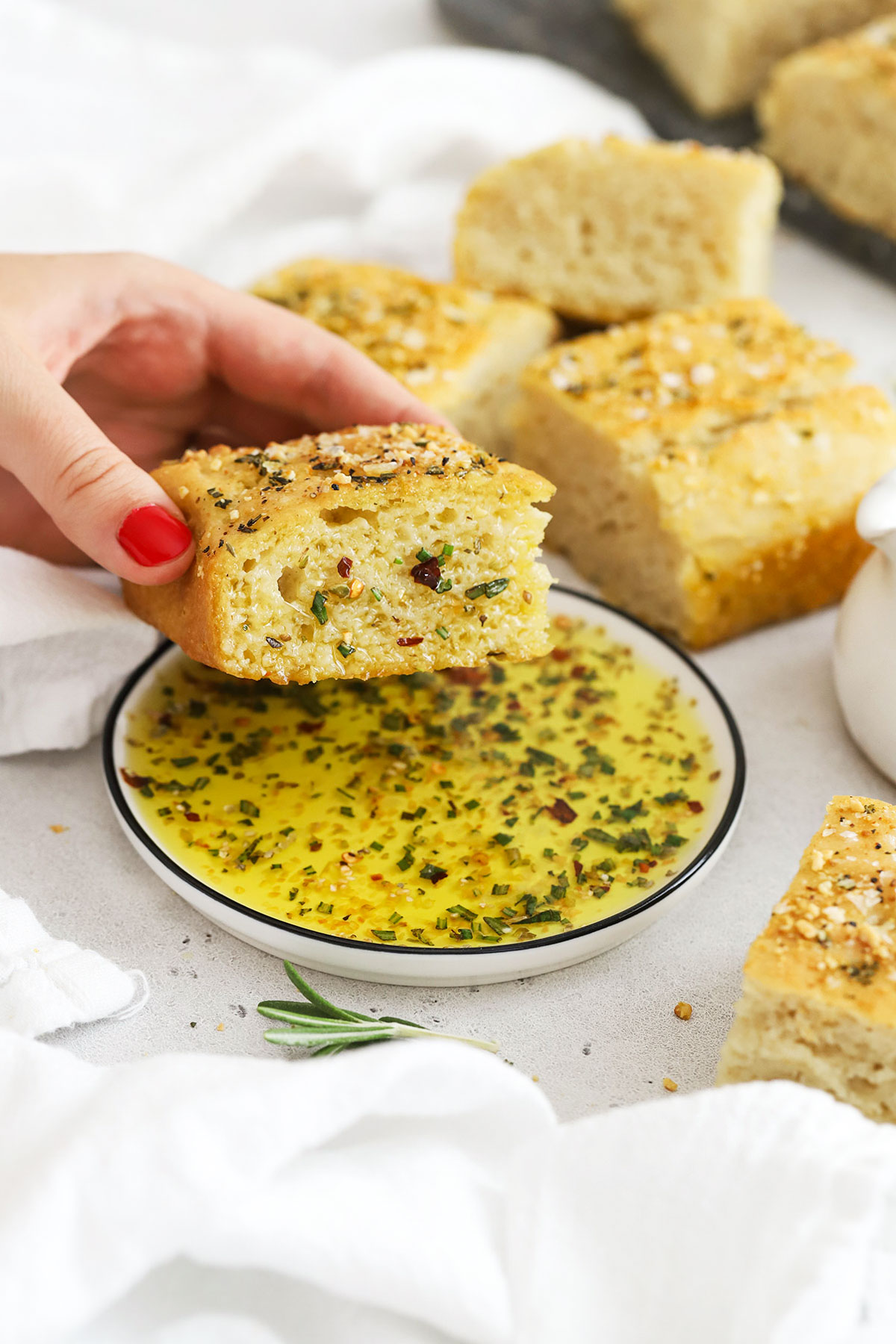
A Few Tips To get This recipe Just Right:
Use Fresh Ingredients
It might seem silly, but it’s important to know you’re using fresh ingredients. If you’re using old baking powder or old yeast, this bread WILL NOT rise no matter what you do. Use this quick test to check your baking powder to see if it’s still active, and watch for the foaming, bubbling reaction in the recipe instructions to make sure your yeast is still active.
Know How To Handle The Dough
If you’ve ever baked with wheat-based flours (white all-purpose, wheat, bread flour, etc.) you’ll be able to tell right away that gluten-free focaccia “dough” is really more like batter. It’s not pliable (there are no gluten or wheat proteins to give it that structure!), and you won’t knead it–you can’t! It’ll be a rather sticky, wet batter instead of a cohesive, stretchy dough. Don’t panic, and DON’T add extra flour!
Use Parchment On Your Pan
Your gluten-free focaccia batter will be sticky, and it can stick to the baking sheet if you don’t prep it. A surefire way to keep your dough from sticking to the pan is to use parchment paper, then drizzle the olive oil on top of it, as directed. I highly recommend you don’t skip the parchment. If you don’t like using parchment paper, at least use a reusable silicone baking mat to help prevent sticking.
Don’t Skimp On Olive Oil. Seriously.
Don’t do it! I know it’ll feel like a lot (especially on the baking pan), but I promise the olive oil is essential for the texture of the interior and exterior of gluten-free focaccia bread. Olive oil helps give that gorgeous crispy crust on the exterior and keeps things light on the interior. I promise your results will not be as good if you try to skimp on the olive oil. It’ll be more dry and spongy. And it won’t get the same gorgeous color. Trust me!
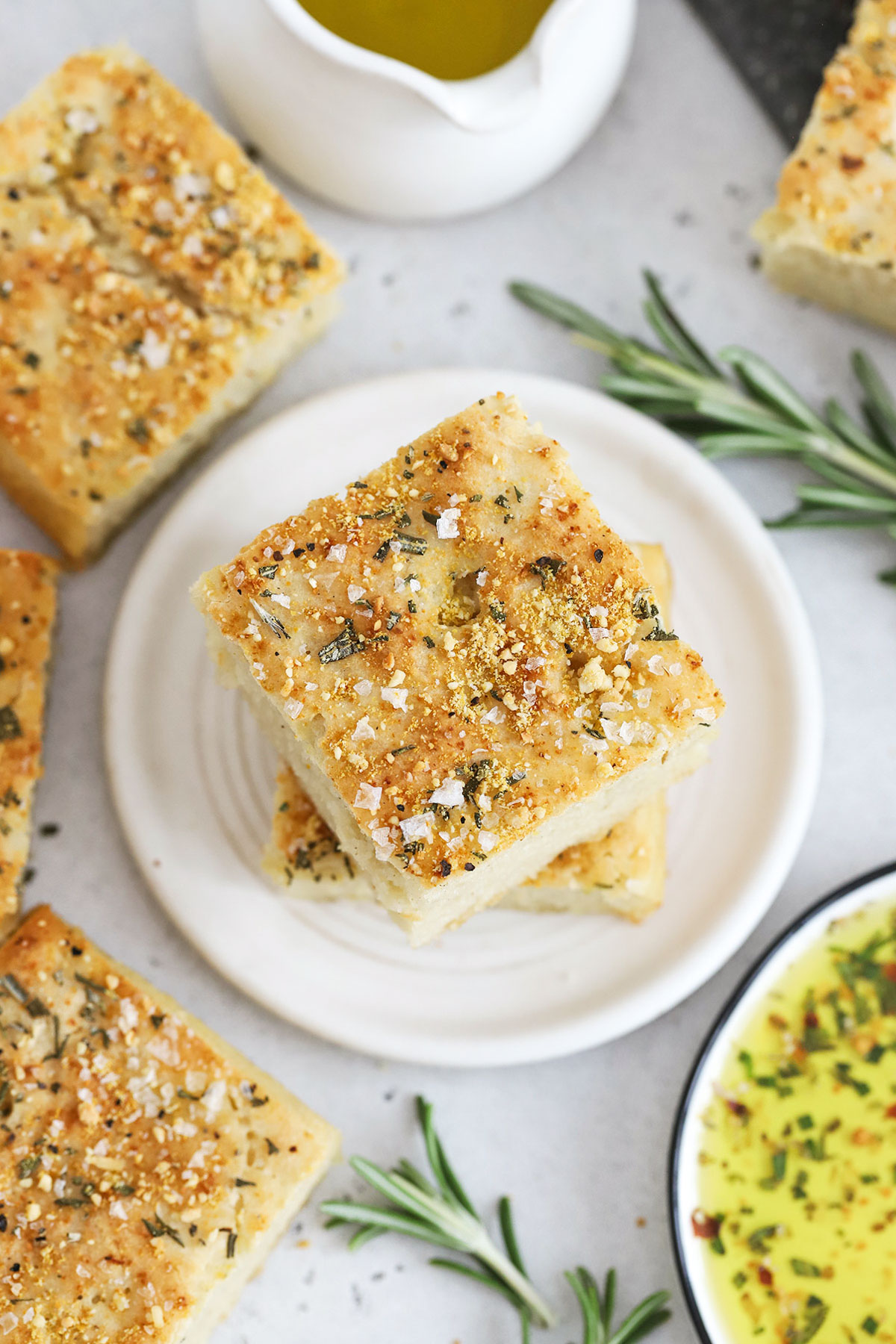
FAQ + MORE IDEAS FOR THIS GLUTEN-FREE FOCACCIA
HOW TO SERVE FOCACCIA – I’ve got to say it: my favorite way is when it’s burn-your-mouth hot from the oven. But. After it’s had enough time to actually cool down somewhat, my favorite way to enjoy gluten-free focaccia is dipped in olive oil. We love to make a seasoned dipping oil to serve with it! (It’s also great with marinara sauce!)
HOW TO STORE FOCACCIA – Like most gluten free baked goods, this gluten-free focaccia bread is best enjoyed in 1-2 days. I store mine wrapped tightly or in an airtight bag with extra air pressed out in the refrigerator, then heat it up in the oven (you can use the microwave or a toaster oven) before serving again.
MORE FOCACCIA TOPPINGS TO TRY. Part of what’s so fun about making this focaccia is choosing the toppings! Since this recipe was originally published in 2019, I’ve had dozens and dozens of readers send me their focaccia photos! Play around with the toppings! Readers have tried:
- Sun-Dried Tomatoes
- Caramelized Onions
- Roasted Garlic
- Olives – black, green, Kalamata, Castelvetrano, etc.
- Edible Flowers
- Fresh Herbs – sage, basil, rosemary, dill, parsley, thyme, etc.
- Dried Herbs & Spices – dried oregano, Italian seasoning, dried basil, red pepper flakes, etc.
- Different cheeses – asiago, parmesan, aged white cheddar, and more!

What To Serve With This Yummy Bread:
⭐ Don’t forget to leave a star review and comment below when you make our Gluten-Free Focaccia recipe. I can’t wait to hear how it goes!
Print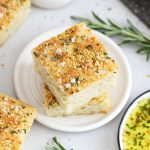
Gluten-Free Focaccia with Rosemary
- Total Time: 1 hour 40 minutes
- Yield: 9–12 slices 1x
- Diet: Gluten Free
Description
Our easy gluten-free focaccia recipe has a perfect crispy crust & tender, fluffy center. It’s the easiest gluten-free bread around! (Vegan-Friendly!)
Ingredients
For Gluten Free Focaccia:
- 2 1/2 cups (300 grams) gluten free 1:1 flour (I highly recommend King Arthur Flour Measure-for Measure flour)*
- 2 teaspoons baking powder
- 1 1/2 cups warm water (ideally 120–130 degrees F.)
- 1 (1/4 oz.) package instant or rapid rise yeast (2 1/4 teaspoons)
- 1 Tablespoon sugar, honey, or agave
- 1 teaspoon kosher salt
- 4 Tablespoons olive oil, divided
For Topping:
- 1 Tablespoon fresh rosemary
- 1–2 Tablespoons vegan parmesan or Parmesan cheese
- 1/2 teaspoon flaky sea salt (like Maldon)
- 1/4 teaspoon black pepper
Instructions
-
Combine Dry Ingredients. In a large mixing bowl, whisk together flour, salt, and baking powder. Set aside.
-
Warm The Water. Warm your water in the microwave or on the stovetop until it’s warm but not hot. (Ideally, the temperature should be between 120-130 degrees F, but you can use the touch test to tell if it’s ok. If the water is too warm to put your finger in comfortably for several seconds, it’s too hot)
-
Bloom The Yeast. Add yeast and honey or sugar to the warm water. Stir to combine, then let it bloom by setting it aside to rest for for 3-5 minutes. (It’ll start to look foamy on top)
-
Combine Wet Ingredients & Dry Ingredients. Pour 2 Tablespoons olive oil and the the water/yeast mixture over the flour mixture and stir to combine. Note that the dough will actually be more like batter than dough. You will not knead it.
-
Transfer To The Pan. Line an 8×8 or 9×9 metal baking pan with parchment paper. Drizzle 2-3 Tablespoons of olive oil onto the parchment. Gently transfer the focaccia dough to the pan and pat it out or spread it with a spatula. (I usually find it easiest to dip my fingertips into the oil and pat it out by hand). Drizzle the top of the dough with 1 more Tablespoon of olive oil.
-
Let The Dough Rise. Cover the pan with plastic wrap or a clean dish towel and set it to rise in a warm place for at least 30 minutes if using rapid rise yeast and about an hour if you use regular yeast. The batter/dough will be roughly double in size.
-
Preheat The Oven. During the last 20 minutes of the rise time, preheat the oven to 400 degrees F.
-
Dimple The Dough. Coat your fingertips with olive oil and use greased fingers to poke several holes in the dough to form the characteristic “dimples” of focaccia. I find this easiest if I drizzle the surface of the dough with a little olive oil first, then use my fingertips to gently spread the oil before making the dimples. (Try not to smash the dough down)
-
Add Toppings. Sprinkle the surface of the dough with fresh rosemary, parmesan or vegan parmesan (if using), coarse sea salt and pepper.
-
Bake at 400 degrees 25-30 minutes, or until golden brown. Remove from oven and let cool at least 10-12 minutes before slicing and eating. Store leftover focaccia in an airtight container at room temperature 2-3 days, or store in the freezer and freeze up to 2 months.
Our original instructions called for making this focaccia free-form on a baking sheet. This produces a more organic shape, but a thinner dough. If you prefer to follow the old instructions, mix up the dough as directed, but let the dough rise in the mixing bowl covered with plastic wrap. Pour 2 Tablespoons of olive oil on a baking sheet lined with parchment and shape the dough into an 8×10 rectangle. Top & bake the bread as directed.
Notes
CHOOSE THE RIGHT FLOUR. I *highly* recommend King Arthur Flour Measure-for-Measure flour for this recipe. Bob’s Red Mill 1:1 flour is my other favorite, but will not get as light, as browned, or as “done” in the center as King Arthur Flour. Some readers report their focaccia stays wet or gummy in the center with Bob’s.
FOR A YUMMY DIPPING SAUCE: Pour 1/3 cup olive oil over granulated garlic, coarse salt, pepper, red pepper flakes, and rosemary, oregano, and/or basil. I usually use 1/4 tsp dried flaked garlic, 1/2 tsp fresh rosemary, 1/4 tsp oregano, 1/4 tsp coarse salt, 1/4 tsp pepper, and 1/4 tsp red pepper flakes
- Prep Time: 15 minutes
- Rise time: 1 hour
- Cook Time: 25 minutes
- Category: Side dish
- Method: Baking
- Cuisine: Italian
Originally posted June 2019. Fully updated with video, photos, and updated instructions Aug 2023.





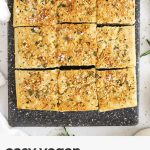

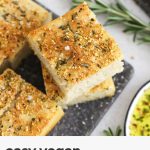
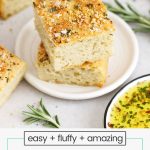
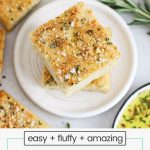
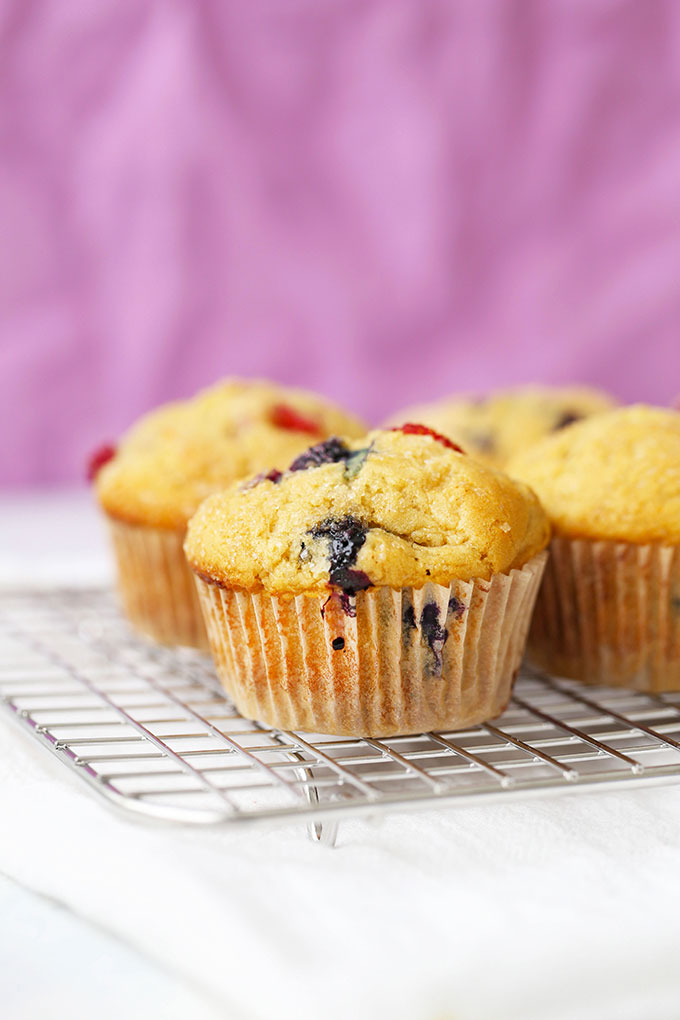
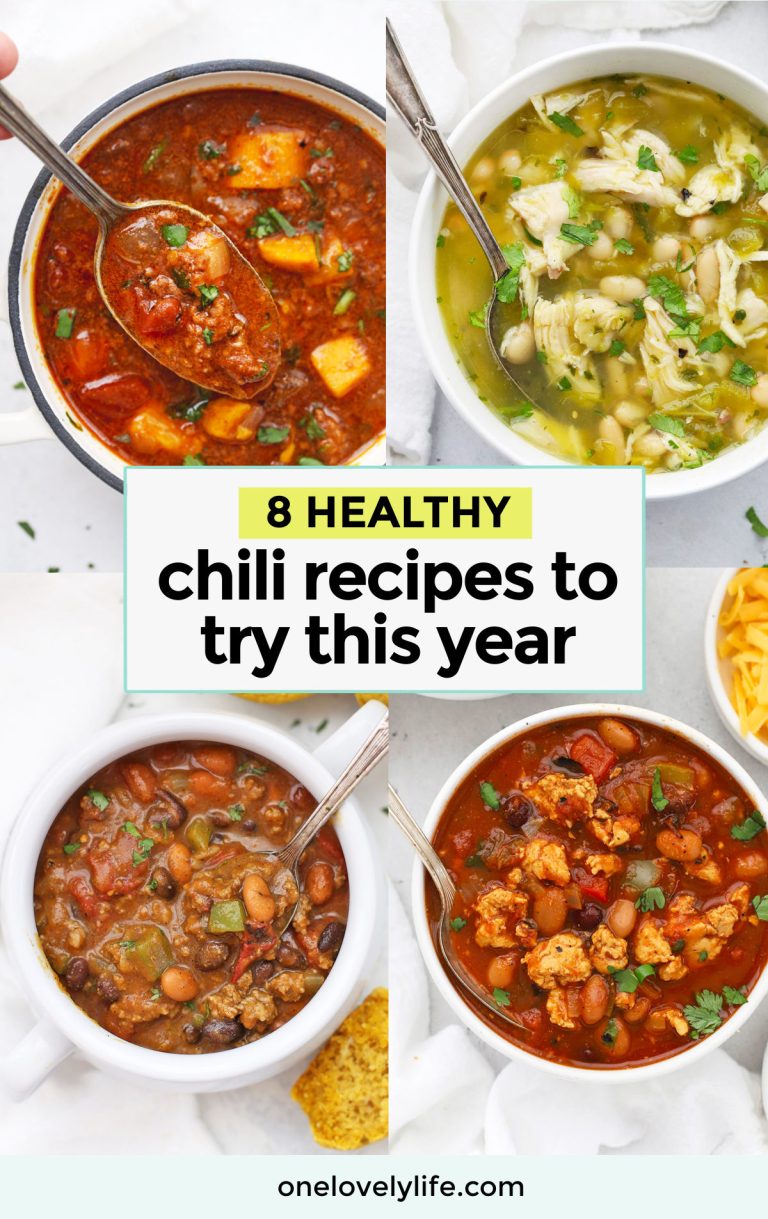
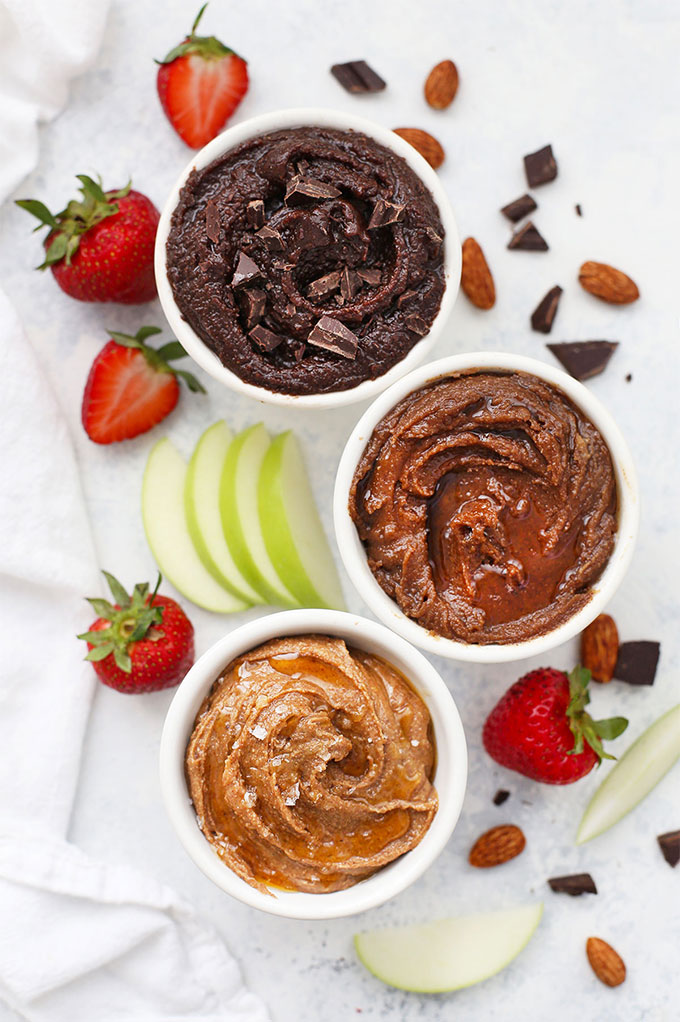
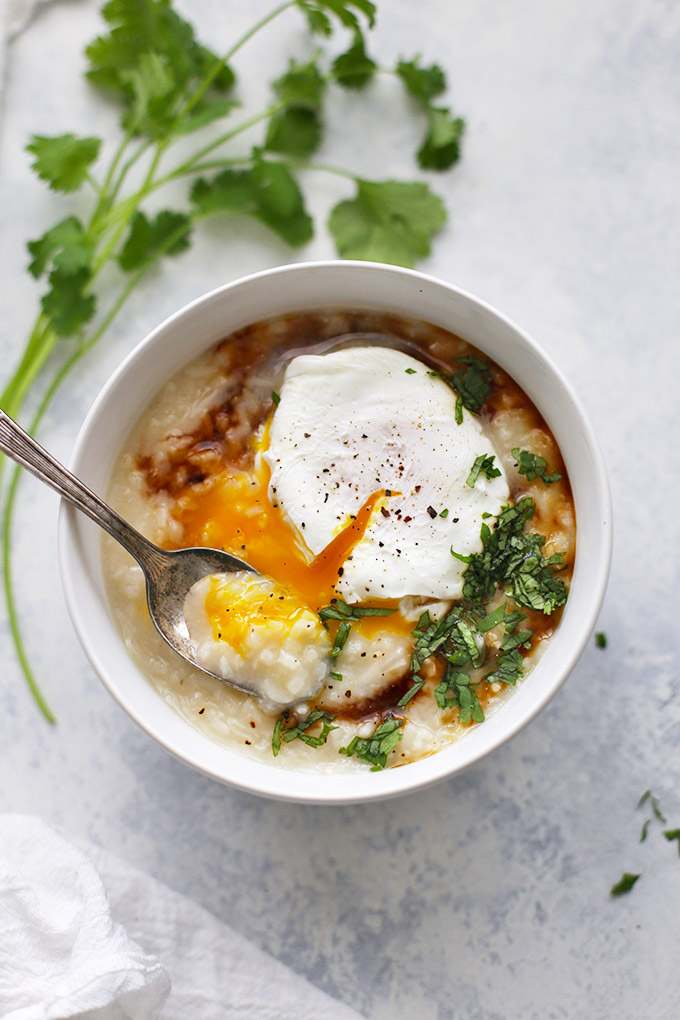

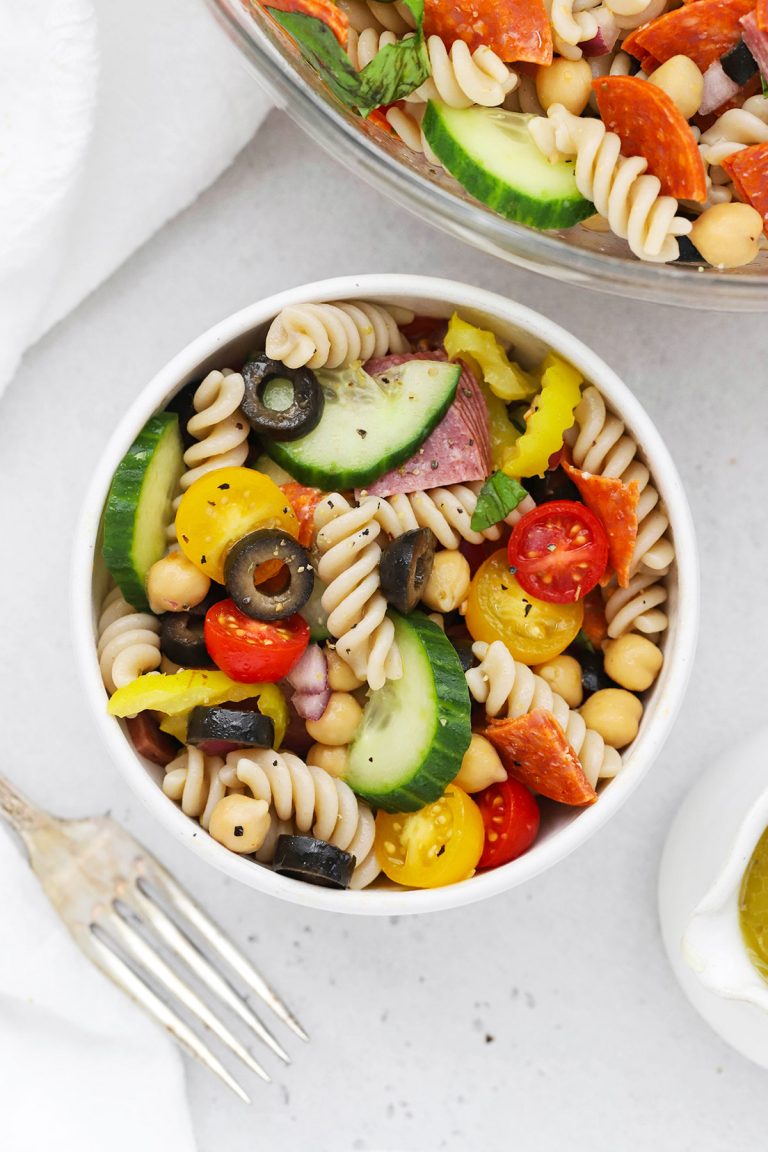
Hi- We made this for our Sunday lunch. It our second recipe we attempted with the San proportion of water to flour. The first recipe was just a soupy slurry. So we reduced the water to 1-1/4 cup and the dough looked a little thicker than yours on the video but more like “normal” biscuit dough. Also we use a mix of 1-1/2 cup rice flour, 1/2 cup potato starch, 1/4 cup tapioca and 1-1/2 tsp of xandamum gum. It came out well! We even topped it with roasted garlic and fresh grape tomatoes.
Thanks for sharing the recipe
I’m so glad it worked out well with your flour blend and adjustments! Way to go!
Emily, THANK YOU. This recipe was such a hit, my family has been dying for some good bread to snack on with dinner, I tried making gluten free bread 7 times with no success. For the first time I made something gluten free and delicious that my whole family enjoyed.
Also, I’d like to add that this recipe was amazing as someone with gluten, dairy, soy, nuts, AND egg allergies.
Thank you so so so much for sharing I cannot wait to bring this to potluck dinners.
That’s FANTASTIC to hear! I’m so glad you loved it! We LOVE it!
Seriously so good. Used bobs 1-1 was a little gummy, but not bad. I think lowering the temperature and letting it bake a couple minutes longer and it would be perfect. I cut the rest of the bread into breadstick and toasted them in the oven for five minutes and holy cow. So good. Taste like Pizza Hut crust/breadsticks but yummier. Recipe was super easy to follow too. Definitely going to be a staple in my house. Thank you for this recipe!
I’m so glad you liked this! I love your breadstick idea. I’ll totally need to try that!
I never bother to comment on food blogs but after tonight I felt compelled to do so.
Holy moley, this is hands-down the best gluten-free bread I have ever made (or eaten!). Soft, fluffy, flavorful, crispy on the edges. I made two pans this evening and between four people there are just a few crumbs left. It was so easy, too! We topped it with some fresh herbs, brushed it with olive oil, and devoured. I have more than my fair share of Pinterest fails so I was just delighted at how well this turned out!
Quick question: I have some garlic lovers in my house; I’m wondering how best to incorporate garlic flavor into the bread. Do you think it would be better to sprinkle fresh garlic on top before baking, or maybe using garlic powder in the dry mix?
Thank you so much for this amazing recipe!
That’s SO NICE of you to say!
For your garlic lovers, you could totally add some garlic powder on the topping or mixed in with the dry ingredients, or you could fold in roasted garlic cloves into the batter before it rises. (Or you can use roasted garlic oil as part of the olive oil in the dough!)
This Gluten free Focaccia was so very good, that I made a second one RIGHT after tasting the first one!
Thank you so much. I didn’t use parchment, but did use olive oil on a GreenPan non-stick pizza tray/cookie sheet. I drizzled olive oil on top of the dough, and found it was easy to spread with my fingers that way. They did not stick to the dough. The focaccia did not stick to the pan either and I had a lovely crisp brown bottom crust. I look forward to trying so many other recipes! Can some one do my laundry, while I stay in the kitchen?
oh, I’m so happy you loved it! Love your olive oil on top trick!
I made another one today!!! This is getting pretty obsessive with me. But I wonder if your website has an easier way to search for recipes…I forgot to put that recipe in my Favourites. I love your website and plan to work my way so many recipes of yours. But, scrolling through the Categories is a little time consuming. However, then I see something else I want to make…and so on, and so on.,,,
Marisa – I’m so glad you’re enjoying it all over again! I’m SO SORRY the current search function is so difficult to navigate. I’m actually in the middle of a redesign that should make this MUCH easier in the future. I hope you’ll stick with me till it’s done! 😉
It’s delicious
I’m so glad you liked it Maggie! Thank you for sharing!
This was the best gluten free crust ever!! I used Bob’s 1-1 flour but added 1/4 tsp. xanthan gum just for good luck since someone else found it was too gummy, and all the rest as written. Instead of your topping (which we will try later) we used carmelized onion, a ripe pear and stilton cheese since we had six ripe pears on hand. My husband says we should use this recipe from now on. It came out crispy on the outside, tender on the inside, perfectly done and soooo good! Thank you!!
Pam – Thank you so much for taking the time to leave a review! I’m so glad you liked it. Your pear + cheese + caramelized onion topping sounds AMAZINGLY good. Yum!
This is the best gluten free bread I’ve had in a long time!! I added a garlic herb seasoning on the top and brushed it with olive oil & added the “dimples” with the back of a tsp measuring spoon about 10 min before taking it out. Thanks for a great recipe!
Oh, I’m SO GLAD to hear it! Your garlic herb seasoning sounds delicious–yum!
Thank you for taking the time to leave a review! It’s so helpful!
I suggest splitting the dough into two different pans, because the bottom crust is perfect, and it’ll save you the effort of trying to cut that chewy inside part without tearing it up.
Thanks for the tip Michelle! 🙂
This is SUCH a great recipe! My husband loved it (and normally hates all GF things). It doesn’t taste gluten free!
WOW! What a nice comment! Thank you so much for sharing this with me–you totally made my day!
👀 omg. Finally a gluten-free recipe that produces good bread. This came out so soft and springy that I ate half of the focaccia bread and I now have a stomach ache because I ate too much. 🥰
I LOVE hearing these success stories! Thank you so much for taking the time to leave a review Emma!
I used bob’s red mill without any problems. It’s what I had on hand. I sifted all dry ingredients and I think that’s an important step with any baked goods.
Made it just as instructed with the only variation being sifting the dry ingredients and then also sprinkling garlic powder on top with the rosemary and Parmesan. It came out perfectly and will definitely be making it again and again!
I’m so glad you loved it!
My GF husband loves this so much that we want to use it as our pizza crust. Do you think we should bake 5-10 minutes first, then add toppings? My concern is that interrupting the baking process may stop it from rising in the oven.
Marci – I haven’t tried this, but it sounds delicious. If you’re using it as pizza crust, I think pre-baking it is a great idea! (That way it can really hold the toppings.) I’d love to know how it goes if you give it a try!
Have made this as pizza crust several times, and pre-baking for 15 minutes seems to be the best. Then add toppings and back in the oven. Also, slightly pre-cooking the veggie toppings also helps, so the crust doesn’t get dried out while you wait for the veggies to cook enough. Best pizza: pesto sauce with fresh sliced mozzarella! My GF husband loves this crust above all others we’ve tried to make or buy!
I’m so glad you love it! We’ve made it as pizza crust too a couple times—so good!
I made a half recipe with the Simple Truth gluten free flour for a friend and he liked the results a lot! I tried a little piece myself first and it had a crispy bottom and spongy middle which was really tasty! I make foccacia with regular flour a lot and found it to be impressively close.
Isaac – I’m so glad it turned out for you! Thank you for sharing with me!
This was a winner. So moist with a nice crust. Definitely will cook again. I’ve been looking for a good GF Rosemary Focaccia bread and this is it!
Yaaaay! I’m so glad you loved it!